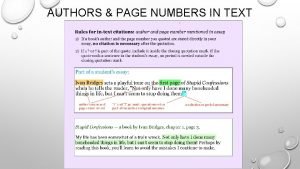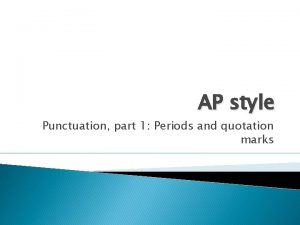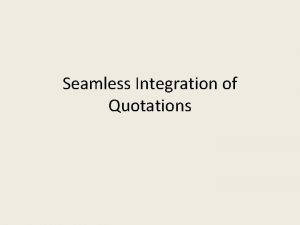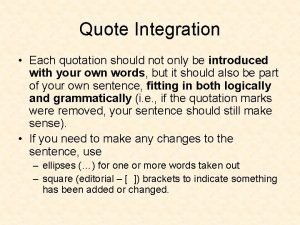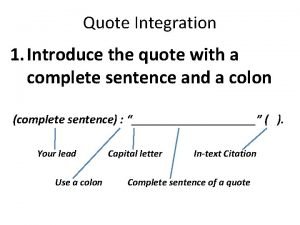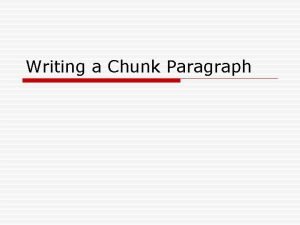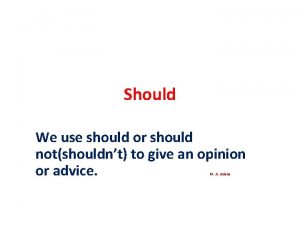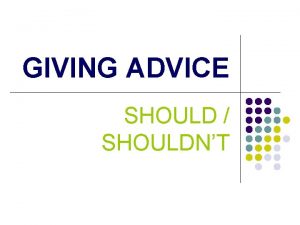Quote Integration When Should I use a quote












- Slides: 12

Quote Integration

When Should I use a quote? Use quotations at strategically selected moments. You have probably been told by teachers to provide as much evidence as possible in support of your thesis. But packing your paper with quotations will not necessarily strengthen your argument.

When Should I use a quote? The majority of your paper should still be your original ideas in your own words (after all, it’s your paper). And quotations are only one type of evidence: well-balanced papers may also make use of paraphrases, data, and statistics.

When Should I use a quote? The types of evidence you use will depend in part on the conventions of the discipline or audience for which you are writing. For example, papers analyzing literature may rely heavily on direct quotations of the text, while papers in the social sciences may have more paraphrasing, data, and statistics than quotations.

Discussing specific arguments or ideas Sometimes, in order to have a clear, accurate discussion of the ideas of others, you need to quote those ideas word for word. Suppose you want to challenge the following statement made by John Doe, a well-known historian: “At the beginning of World War Two, almost all Americans assumed the war would end quickly. ” If it is especially important that you formulate a counterargument to this claim, then you might wish to quote the part of the statement that you find questionable and establish a dialogue between yourself and John Doe.

Giving added emphasis to a particularly authoritative source on your topic There will be times when you want to highlight the words of a particularly important and authoritative source on your topic. Suppose you were writing an essay about the differences between the lives of male and female slaves in the U. S. South. One of your most provocative sources is a narrative written by a former slave, Harriet Jacobs. It would then be appropriate to quote some of Jacobs’s words: Harriet Jacobs, a former slave from North Carolina, published an autobiographical slave narrative in 1861. Example: “She exposed the hardships of both male and female slaves but ultimately concluded that ‘slavery is terrible for men; but it is far more terrible for women. ’ In this particular example, Jacobs is providing a crucial first-hand perspective on slavery. Thus, her words deserve more exposure than a paraphrase could provide.

How do I set up and follow up a quotation? Once you’ve carefully selected the quotations that you want to use, your next job is to weave those quotations into your text. The words that precede and follow a quotation are just as important as the quotation itself. You can think of each quote as the filling in a sandwich: it may be tasty on its own, but it’s messy to eat without some bread on either side of it. Your words can serve as the “bread” that helps readers digest each quote easily. Below are four guidelines for setting up and following up quotations.

How do I set up and follow up a quotation? Do not rely on quotations to tell your story for you. It is your responsibility to provide your reader with context for the quotation. The context should set the basic scene for when, possibly where, and under what circumstances the quotation was spoken or written.

Attribute each quotation to its source Tell your reader who is speaking. Here is a good test: try reading your text aloud. Could your reader determine without looking at your paper where your quotations begin? If not, you need to attribute the quote more noticeably. Avoid getting into the “he/she said” attribution rut! There are many other ways to attribute quotes besides this construction.

Explain the significance of the quotation Once you’ve inserted your quotation, along with its context and attribution, don’t stop! Your reader still needs your assessment of why the quotation holds significance for your paper.

Provide a citation for the quotation https: //owl. purdue. edu/owl/res earch_and_citation/mla_style/ mla_formatting_and_style_gui de/mla_formatting_and_style_ guide. html

Will you use quotes? Well, you should! Practice on the discussion boards.
 How to quote a quote apa
How to quote a quote apa Dialogue quote vs flow quote
Dialogue quote vs flow quote Integrating quotes
Integrating quotes Dancing with demons yelena garcia
Dancing with demons yelena garcia Period inside or outside quotes ap style
Period inside or outside quotes ap style Quote integration methods
Quote integration methods Integrated quotes examples
Integrated quotes examples Mla quotation integration
Mla quotation integration Integrated quotes examples
Integrated quotes examples Block quotation example
Block quotation example Colon quote integration
Colon quote integration Two chunk paragraph format
Two chunk paragraph format Three dimensions of corporate strategy
Three dimensions of corporate strategy



